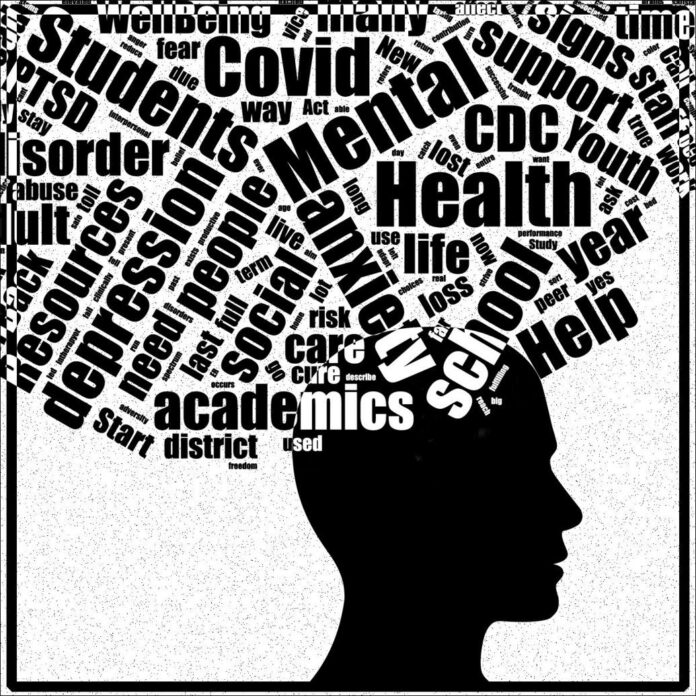As more and more youth experience negative mental health impacts fueled by years of natural disasters and a pandemic, local school counselors and mental health experts are seeing an uptick in requests by adolescents for social-emotional support.
“We see students experiencing social-emotional effects due to many factors, both in their own life events, and those specifically due to COVID-19 related impacts. This is evident through the notable increase in requests for on-campus voluntary social-emotional services, on-site crises and requests in navigating local resources, as compared to fewer requests for services in previous years,” social-emotional counselors Maritza Dragoman and Relyn Loiseaux wrote in a statement to SoCoNews.
Dragoman and Loiseaux work as social-emotional counselors at the Windsor Unified School District (WUSD).
The two counselors said a broad range of WUSD high school students are referred or self-referred to services, including “straight A” students, athletes and socially outgoing students.
The youth mental health crisis isn’t just touching Sonoma County. On Dec. 7, 2021, U.S. Surgeon General Dr. Vivek Murthy issued a surgeon general advisory on the youth mental health crisis further propelled by COVID-19.
“Mental health challenges in children, adolescents and young adults are real and widespread. Even before the pandemic, an alarming number of young people struggled with feelings of helplessness, depression, and thoughts of suicide — and rates have increased over the past decade,”Murthy said in a U.S Department of Health and Human Services press release.“The COVID-19 pandemic further altered their experiences at home, school and in the community, and the effect on their mental health has been devastating.”
School counselors, school site administrators and licensed family therapists are seeing firsthand COVID’s impact on child and adolescent and mental health.
“This school year, a substantial number of students and parents have requested our short-term school mental health supports, and have reported to us many roadblocks in obtaining therapists through their insurance or even out-of-pocket providers. Many say they are either on long waitlists to obtain services, or are told there are no openings for teen therapists locally. Additionally, many therapists also only have availability during school hours and some students and parents aren’t willing to have their student miss school to attend appointments,” Dragoman and Loiseaux said.
According to the counselors, due to reported mass shortages of therapists both locally and nationally, the frequency of appointments being offered is inconsistent — occurring only once a month or every few weeks — making it more difficult for people to improve their mental health.
Dragoman and Loiseaux said students they see typically display symptoms of anxiety, trauma, depression and an increased presence of suicidal thoughts or attempts, aggression towards others, self-harming behavior and risk-taking behavior like reckless driving, substance abuse or increased promiscuity.
Looking at national statistics, there’s been an overall increase in psychiatric hospitalizations and emergency room visits amid adolescents struggling with suicidality and mental health-related issues.
Dragoman and Loiseaux noted that the Centers for Disease Control and Prevention (CDC) found an uptick in mental health-related emergency room visits for children early on in the pandemic when compared to 2019, as well as a 50.6% increase in suspected suicide attempt emergency room visits among girls ages 12 to 17.
According to the U.S. Department of Health and Human Services, between 2007 and 2018, suicide rates among youth ages 10 to 24 in the U.S. increased by 57% and early estimates show over 6,600 suicide deaths among this age group in 2020.
In addition to dealing with the pandemic, Sonoma County’s youth have experienced a cocktail of natural disasters and the WUSD counselors said it’s important to remember that juniors, sophomores and freshmen have not experienced a “normal” year of high school.
“Our community has not only been faced with COVID, but has also spent the last five years experiencing wildfires, evacuations, power outages, etc., that have collectively increased the amount of trauma and anxiety responses that students and their families are experiencing,” Dragoman and Loiseaux said.
Healdsburg High School student Indica Carroll said while a lot of kids are happy to be back on campus, at the same time, many were scared or anxious about coming back in person because of COVID.
Carroll is the co-president of Healdsburg’s Bring Change to Mind Club, a localized faction of a nationwide organization of high school clubs that aim to reduce the stigma around mental health.
According to the most recent CoVitality Survey data, 37% of Healdsburg High students said they are thriving, while 48% said they’re just getting by, and 15% identified as the highest risk.
At Healdsburg Junior High School, 42% of students said they are thriving and another 42% said they are getting by, while 17% identified as highest risk.
“Our students have been through issue after issue and trauma after trauma in Sonoma County, and this is the year we came back fully on an in-person schedule after our students experienced the isolation and the anxiety that came forth from distance learning,” Healdsburg Unified School District (HUSD) Superintendent Chris Vanden Heuvel said during a Jan. 19 school board meeting.
Cathleen Stafford, a licensed marriage family therapist who serves clients in Sonoma County, works with clients ages 8 to 18 and up and said she’s seen an increase in clients since the start of the pandemic.
“The mental health field is definitely taxed right now because there is a definite need. What I’ve really noticed is the younger generation is reaching out more (for aid),” Stafford said.
If she were to sum it up, Stafford said the state of youth mental health is full of angst, uncertainty and frustration.
“I felt we kind of plateaued for a while and we were able to vaccinate if we chose to and were able to widen our bubbles. Then with the new variant, everything changed again and we were all thrown a curveball. Now we’re having to pivot again and it’s taking a lot of learning about flexibility and how to turn the uncertainty into having some control in our lives and how to behave in certain situations,” Stafford said.
Stafford said not only is the pandemic affecting children and adolescents’ mental health, but the mental health of parents as well.
“Anybody who has preschoolers to adolescents are struggling with the situation because if you are sent home and you can’t go to school and if you’re in a single-parent household or if both parents need to work, it really creates stress for everybody, it’s so far-reaching,” Stafford said.
She said this means both child and parent are enduring that stress and anxiety.
“That’s really what I’ve seen in my practice, and really that uncertainty of never knowing when you’re going to have to pivot.”
Stafford said that in older kids, she’s seeing a craving for normalcy and the sense that they’re “over it” with the pandemic. She said the age group of kids who graduated from high school in 2020 are having a rough time adjusting to remote college or distance learning.
“I think they feel like they are kind of getting robbed. I’ve had kids who got into excellent schools and they weren’t, ‘rewarded’ with the ability to go off to school and enjoy that. We have to work through a lot of issues of having to deal with learning how to accept the way things are and what things are in our control and what things are out of our control and being able to create happiness with what the current situation is,” Stafford said.
The mental health impacts of COVID can vary for young children depending on each family, according to Stafford. She said parents have been able to create their own little stable cohort allowing kids to interact with some other kids, but others have to be more stringent when it comes to interaction.
“The younger kids are having a hard time making friends and that leads to loneliness, depression and isolation and that’s really been very prevalent in my practice, and I would say in the last year it’s gotten worse,” Stafford said.
Erin Elo, the manager for the West County Teen Clinic, also reported a significant increase in both the need they see for youth mental health services, and in young people reaching out for help.
“We used to see very rare self-referral into therapy for young people. Now we have folks that are reaching out for therapy,” Elo said.
In some cases, individuals are struggling to find care due to the current high demand in mental health services. Elo said they don’t have enough therapists to see all of these kids because the need is so high.
With the teen clinic, Elo runs a peer education program with 20 young people who volunteer for the program who represent seven different area high schools. Before SoCoNews’ interview with Elo, Elo reached out to her volunteer network and asked, “what is the state of mental health with your peers, and how are you doing?”
“There was a varied response. Many of them said it is overwhelming the amount of anxiety and depression that they feel not only on their own, but amongst their peer groups and that they are kind of forgetting how to be human together,” Elo said.
Like other Sonoma County youth, west county adolescents are dealing with the stress and trauma of natural disasters, but they’re also dealing with the added stress of high school consolidation and school board politics.
“The kids are just really struggling and then they have this on top of it,” she said.
The uncertainty that comes with the COVID pandemic is also an issue.
“Young people used to lean on us for answers and now we don’t always have them, or I have an answer today and tomorrow it’s different, and so there’s not this strong, solid base amongst the folks that are leading the adults and then the adults that are leading the young people. It’s just a lot of upset for our kiddos,” Elo said.
She added that many youths in Sonoma County do not have the best home environment and COVID is trapping them in that environment. attending school or extracurricular activities would normally provide solace from that, however, the last few years have been riddled with stay-at-home orders and distance learning stints. She said it’s saddening watching what local youth today are going through.
The West County Teen Health Clinic is run under the West County Health Centers, a consortium of clinics that offer primary care, dental care and behavioral health and wellness. The teen clinic offers sex education and full-scale reproductive and sexual health services for people aged 12 to 25.
They also offer free behavioral health therapy and a school-based program where they interact with students, answer questions and provide help. Students can walk-in or call for mental health services appointments, but Elo said many times kids will direct message them on their Instagram page. Their handle is @wcteenclinic.
Coping with it all
So how can today’s youth cope with all of this stress, anxiety, uncertainty and other mental health concerns? Stafford said the tactic that works best for managing these issues can vary from person to person.
“A lot of my clients benefit from cognitive behavioral therapy (CBT) where we work on skill-building and homework assignments to work on in between sessions,” Stafford said.
According to the American Psychological Association, CBT treatment typically involves efforts to change thinking patterns and behavioral patterns. Some of these efforts include learning how to recognize distortions in thinking that create problems and how to reevaluate them; using
problem-solving skills to cope with difficult situations; learning how to develop a greater sense of confidence in one’s abilities; learning how to calm one’s mind and relax one’s body; and facing fears instead of avoiding them.
“And then we talk a lot about the parts of themselves so we can help a person learn how to compartmentalize part of their anxiety, or their stress, or their depression so it doesn’t consume them,” Stafford said, adding that some of her clients also benefit from journaling. “They take their journaling time as a way to organize their thoughts and then they can share it with me and talk about it in session.”
Elo said kids all have their own outlets when it comes to coping with mental health issues.
She said she finds that kids who participate in school sports, the arts, or in clubs have a better time coping with various mental health concerns. She said the kids who struggle more, are those who don’t have a hobby or extracurricular activity and are more disconnected from the community in general.
She said kids like these are often more resilient together rather than alone.
Over at the HUSD, the district employs a district-wide psychologist and counselors for school sites. The district also offers a district mental wellness warmline at 707-431-3117.
“We were a little surprised that in secondary students were reporting that they don’t know how to ask for help and they didn’t know how to access services and so we’ve pushed out a self referral form and the counselors are going to work on going into classes and making presentations,” HUSD Director of Student Support Services Diane Conger said during a December school board meeting.
Carroll said the Bring Change to Mind Club likes to host events around mental health when they can.
“In the past before COVID, we used to bring in emotional support dogs for the week of finals,” Carroll said.
She said they found that it helped students with stress during finals week. The club has also hosted events on Zoom where students can come and ask questions about mental health. They’ve also hosted speakers who come via Zoom and present on a certain topic, such as eating disorders, according to Carroll.
Carroll said one of the things that she suggests for stress is taking time for yourself, whether that’s exercising, watching your favorite show, or doing an at-home facial.
Windsor High School has two school social-emotional counselors and academic counselors and runs a calendar of recurring parent and student support events. On their website you can also search for counseling resources and local counseling providers such as SOS Windsor, Alliance Medical Services, Kaiser and more.








